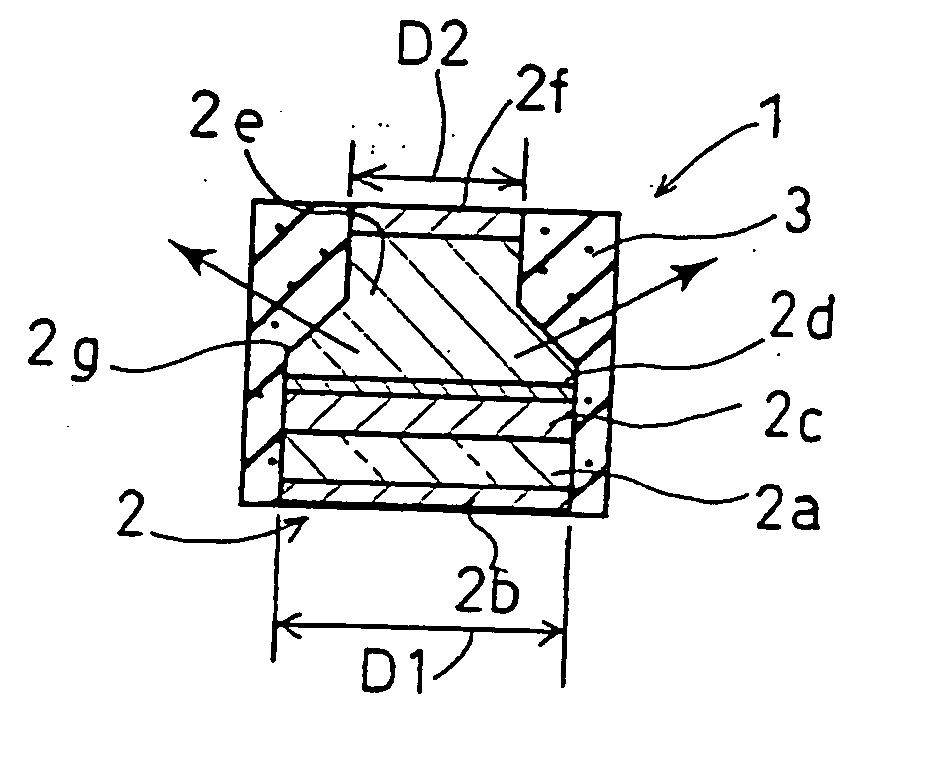Process for producing light-emitting diode element emitting white light
a technology of light-emitting diodes and white light, which is applied in the direction of optical articles, solid-state devices, other domestic articles, etc., can solve the problems of large cost, inevitably formed irregularities at the surface, and considerable increase in manufacturing costs, so as to achieve easy and reliable
- Summary
- Abstract
- Description
- Claims
- Application Information
AI Technical Summary
Benefits of technology
Problems solved by technology
Method used
Image
Examples
first embodiment
[0061]FIGS. 1-14 show the present invention.
[0062] Of these figures, FIGS. 1 and 2 show an LED element 1 to be manufactured in the first embodiment.
[0063] The LED element 1 includes an LED chip 2, and a coating 3 made of a light-pervious synthetic resin containing a fluorescent material and covering the side surfaces of the LED chip 2. The LED chip 2 includes opposite end surfaces at which an anode electrode 2f and a cathode electrode 2b are provided, respectively, which are exposed without being coated with the coating 3.
[0064] As is conventionally known, the LED chip 2 includes at least a substrate 2a having a lower surface on which the cathode electrode 2b is provided, and an upper surface on which an n-type semiconductor layer 2c, a light-emitting layer 2d for emitting blue light, a p-type semiconductor layer 2e and the anode electrode 2f are stacked.
[0065] In the LED element 1 having the above structure, since the side surfaces of the LED chip 2 are coated with the coating 3...
second embodiment
[0082]FIGS. 15-21 show the present invention.
[0083] Of these figures, FIGS. 15 and 16 show a light-emitting diode element 1′ to be manufactured in the second embodiment.
[0084] The LED element 1′ includes an LED chip 2′ having an end surface at which both of an anode electrode 2f′ and a cathode electrode 2b′ are provided. The entirety of the LED chip 2′ except the end surface provided with the anode electrode 2f′ and the cathode electrode 2b′ is coated with a coating 3′ of a light-pervious synthetic resin containing a fluorescent material.
[0085] As is conventionally known, the LED chip 2′ includes at least a transparent substrate 2a′ made of e.g. sapphire and having a surface on which are stacked an n-type semiconductor layer 2c′, a light-emitting layer 2d′ for emitting blue light, a p-type semiconductor layer 2e′, the cathode electrode 2b′ for the n-type semiconductor layer 2c′, and the anode electrode 2f′ for the p-type semiconductor layer 2e′.
[0086] In the LED element 1′ having...
PUM
| Property | Measurement | Unit |
|---|---|---|
| fluorescent | aaaaa | aaaaa |
| light emission brightness | aaaaa | aaaaa |
| thickness | aaaaa | aaaaa |
Abstract
Description
Claims
Application Information
 Login to View More
Login to View More - R&D
- Intellectual Property
- Life Sciences
- Materials
- Tech Scout
- Unparalleled Data Quality
- Higher Quality Content
- 60% Fewer Hallucinations
Browse by: Latest US Patents, China's latest patents, Technical Efficacy Thesaurus, Application Domain, Technology Topic, Popular Technical Reports.
© 2025 PatSnap. All rights reserved.Legal|Privacy policy|Modern Slavery Act Transparency Statement|Sitemap|About US| Contact US: help@patsnap.com



